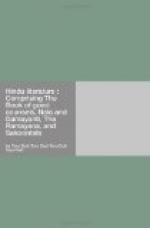‘Sixteen,’ replied the Vulture.
‘Are the alliances numbered therein?’ asked the King.
‘No! these be four,’ answered the Vulture, ’namely—of mutual help—of friendship—of blood—and of sacrifice.’
‘You are a great diplomatist!’ said the King. ’Advise us which to choose!’
’There is no Peace like the Golden “Sangata,” which is made between good men, based on friendly feeling, and preceded by the Oath of Truth,’ replied the Vulture.
‘Let us make that Peace!’ said the Goose. Far-sight accordingly, with fresh presents of robes and jewels, accompanied the Goose to the camp of the Peacock-King. The Rajah, Jewel-plume, gave the Goose a gracious audience, accepted his terms of Peace, and sent him back to the Swan-King, loaded with gifts and kind speeches. The revolt in Jambudwipa was suppressed, and the Peacock-King retired to his own kingdom.
“And now,” said Vishnu-Sarman, “I have told your Royal Highnesses all. Is there anything remaining to be told?”
“Reverend Sir!” replied the Princes, “there is nothing. Thanks to you, we have heard and comprehended the perfect cycle of kingly duty, and are content.”
“There remains but this, then,” said their Preceptor:—
’Peace and
Plenty, all fair things,
Grace the realm
where ye reign Kings;
Grief and loss
come not anigh you,
Glory guide and
magnify you;
Wisdom keep your
statesmen still
Clinging fast,
in good or ill,
Clinging, like
a bride new-wed,
Unto lips, and
breast, and head:
And day by day, that these
fair things befall,
The Lady Lukshmi give her
grace to all.’
[21] A young Brahman, being invested with the sacred thread, and having concluded his studies, becomes of the second order: a householder.
NALA AND DAMAYANTI
[Selected from the “Mahabharata” Translation by Sir Edwin Arnold]
INTRODUCTION
The “Mahabharata” is the oldest epic in Sanscrit literature, and is sevenfold greater in bulk than the “Iliad” and “Odyssey” taken together. This remarkable poem contains almost all the history of ancient India, so far as it can be recovered, together with inexhaustible details of its political, social, and religious life—in fact, the antique Hindoo world stands epitomized in it. The Old Testament is not more interwoven with the Jewish race, nor the New Testament with the civilization of Christendom, nor even the Koran with the records and destinies of Islam, than is this great Sanscrit poem with the unchanging and teeming population of Hindostan. The stories, songs, and ballads, the genealogies, the nursery tales and religious discourses, the art, the learning, the philosophy, the creeds, the modes of thought, the very phrases and daily ideas of the Hindoo people are taken from this poem. Their children are named after its heroes; so are their cities, streets, and even cattle. It is the spiritual life of the Hindoo people. It is personified, worshipped, and cited as being something divine. To read, or even to listen, is to the devout Hindoo sufficiently meritorious to bring prosperity to the fireside in this world, and happiness in the world to come.




